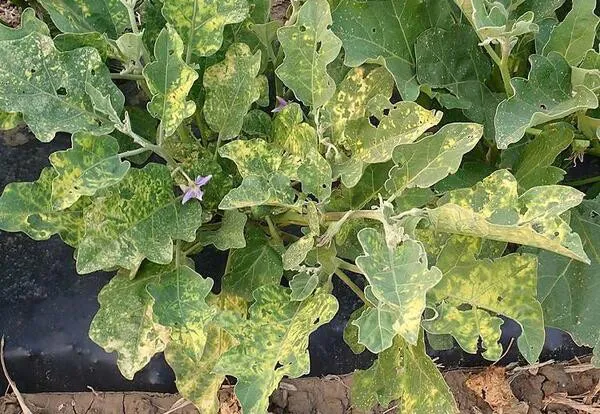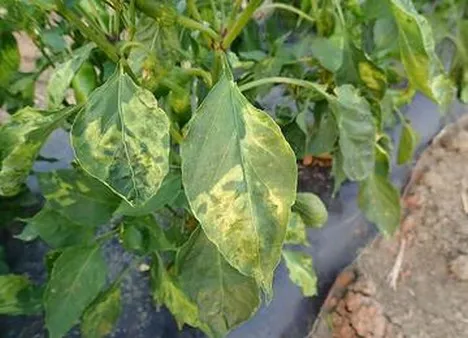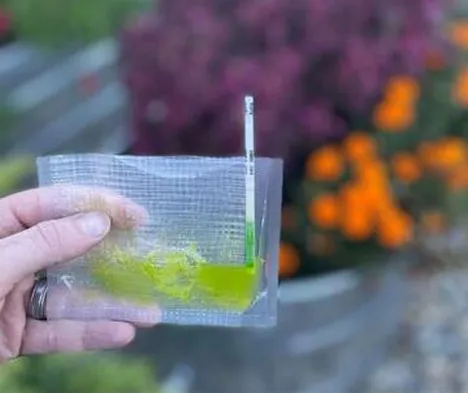Agdia, a provider of plant pathogen diagnostic products and services, announces the commercialization of a rapid, user-friendly product for the detection of Alfalfa mosaic virus on their ImmunoStrip platform.
Alfalfa mosaic virus (AMV) is the type member and singular species within the Alfamovirus genus, which is included in the Bromoviridae family with Bromovirus, Cucumovirus, Ilarvirus, and Oleavirus genera. Symptomology was first described in 1931 on alfalfa plants (Medicago sativa) in California, and AMV is now confirmed to infect more than 600 species of plants, causing significant crop losses in many. Hosts include many economically important species within Amaranthaceae, Asteraceae, Fabaceae, Lamiaceae, and Solanaceae, in addition to several weedy species common in regions of intensive agriculture and horticulture. This virus is now widespread throughout Africa, Asia, Europe, North America, Oceania, and South America.

Figure 1. Symptoms of AMV infection on eggplant. Image courtesy of Whitney Cranshaw, Colorado State University, Bugwood.org.
Symptoms vary by host, environment, plant age, and strain of AMV. Susceptible varieties of alfalfa, also known as lucerne, can express symptoms of light green or yellow mottling and mosaic, localized and systemic necrosis, leaf and petiole distortion, and stunting. Symptoms can be more pronounced during Spring and Fall, becoming inconspicuous in the Summer months. Furthermore, AMV infections can weaken plants and predispose stands to drought stress and cold damage. Solanaceous plants will typically express foliar symptoms of yellow to white mosaic and deformation. In addition, tomatoes can develop fruit discoloration and necrosis, and lethal vascular necrosis. Peppers can exhibit stunted fruit, while potatoes can develop plant stunting, tuber deformation, and necrosis when infected, rendering market products unsalable.
Alfalfa mosaic virus can cause similar foliar and stunting symptoms in annual bedding plants, herbaceous perennials, and woody ornamentals, including Dianthus, Hibiscus, Hydrangea, Impatiens, Lavandula, Peonia, Petunia, and Phlox. Furthermore, AMV is known to infect industrial hemp (Cannabis sativa), causing many in the broader cannabis production markets to screen mother plants, propagative materials, and mature plant inventories for this pathogen.

Figure 2. Symptoms of AMV infection on pepper. Image courtesy of Whitney Cranshaw, Colorado State University, Bugwood.org.
Several species of aphids (Hemiptera) are known to vector AMV in a nonpersistent, noncirculative manner. Virus acquisition time from infected plants is brief, taking seconds to minutes. The subsequent relationship between the aphid vector and AMV is transient in nature; transmissible virus particles do not enter vector cells, nor do they circulate within the vector. Virions are retained at surface sites within the style through direct protein interactions with the virus capsid. Thereafter, aphids remain viruliferous for short periods of time, and the inoculation efficacy of healthy plants is short-lived. Nevertheless, due to their polyphagous nature, high fecundity, winged forms capable of dispersion, and highly efficient feeding apparatuses, aphids are the most important method of local AMV transmission in many crops.
In addition to aphid vectors, AMV can be spread via mechanical transmission, dispersion of infected pollen, and movement of infected seed. Nevertheless, AMV is not seed-transmitted in all hosts, and localized outbreaks are typically the result of a combination of dispersal paradigms. Therefore, these epidemics are difficult to predict, and management is multi-faceted. Long-distance dispersal of AMV occurs via the interstate movement of infected propagative materials. Diagnostic screening of all propagative materials, including seeds, cuttings, and tissue culture products, is the most effective method for limiting the movement of AMV over long distances.
Agdia states their new ImmunoStrip product for detection of Alfalfa mosaic virus was screened against a diverse group of isolates in Subgroup I from several geographic locations. Furthermore, no cross-reactivity was observed when tested against a broad specificity panel, including Apple mosaic virus, Arabis mosaic virus, Bean common mosaic virus, Cucumber mosaic virus, Impatiens necrotic spot virus, Soybean mosaic virus, Tobacco mosaic virus, Tomato mosaic virus, Tobacco ringspot virus, Tobacco streak virus and Tomato spotted wilt virus. This assay was developed to be used with leaf tissue for all hosts and was validated for use on alfalfa, pepper, soybean, and tomato seeds.

Figure 3. Image of ImmunoStrip results.
Agdia’s ImmunoStrip platform provides users with a powerful diagnostic tool, as it can be used as an effective pathogen screen in the field and lab, requiring no special equipment or diagnostic experience. Results are obtained in 30 minutes or less, and interpretation is simple. Results appear as a control and test line, indicating a positive, or a control line only, indicating a negative.
For more information:
Agd ia
ia
52642 County Road 1
Elkhart, IN 46514
phone 1-574-264-2615
fax 1-574-264-2153
[email protected]
www.agdia.com
